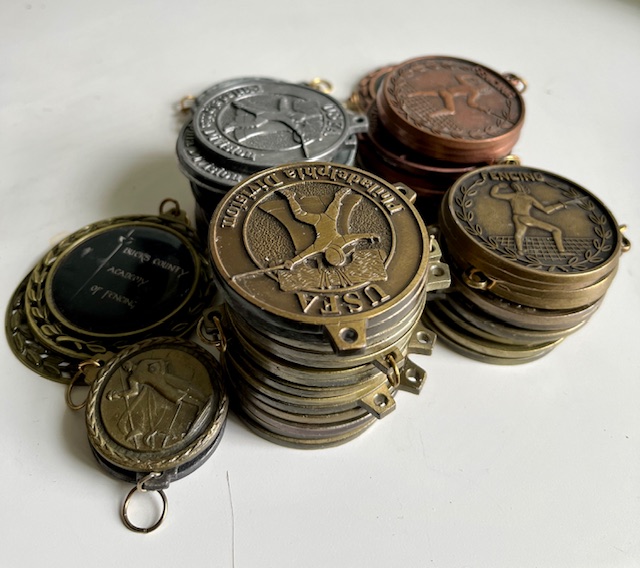When I started fencing in the 1990s, the Philadelphia Division of USA Fencing had three clubs, and each club ran regular small tournaments. Most competition in the US at that point was at the division level, and though the other two clubs in my division were at least an hour away, I went to every tournament I could.
This explains one enormous category of my medals.

Once the division had a handful of women’s sabre fencers, the clubs happily started hosting women-only competitions for us, alongside the regular mixed events, because more entries meant more entry fees. Clubs made a good bit of their income by offering tournaments, plus it was a way for their fencers to gain experience. Besides, any tournament over 6 people earned the winner an E classification, and any tournament over 15 people had the possibility of even higher classifications. The more rated fencers a club had, the higher they were seeded in regional and national events, so it paid off back then to create as many local tournaments as possible.
There were only three clubs in the division back then, and only one of them was actually in Philadelphia: Fencing Academy of Philadelphia, where I started out and fenced for a long time. It was in a storefront in West Philadelphia, a brisk walk from the Philadelphia train station.
Bucks County Academy of Fencing was Mark Holbrow’s club in New Hope, PA, and it was located in a little theater building in charming New Hope. Tournaments at BCAF were held either in the basement, where we kept hitting the columns that separated the strips, or in the second floor, which was more spacious but slippery, and not air conditioned. Circle d’Escrime was in Sellersville, on the second floor of another charming building, with lots of varnished wood and brick interior walls.
None of the three clubs really had any sabre, so sometimes the women’s event was me and my teammates Cindy and Louise, making a road trip of it. We also often entered the open (meaning mixed men and women) event, so that we could get some more fencing for our travel, and so the clubs could have bigger events. I can’t tell you how many tournaments I entered in order to “lend my rating,” because as long as I finished in the top half of the tournament with my D (later an A) someone was going to get a better rating.
I could usually beat Cindy and Louise, which explains a chunk of the 29 gold medals, and even when more women started moving into sabre, I was still the most experienced woman in the division and was still winning women’s events into my late sixties. I often medaled in the mixed events, too.
But for the most part, they all used the division medals, even the newer clubs that came and went. And for the most part, no one labeled the medals, not even with the year. So I have 65 Philadelphia Division medals – 29 golds, 13 silvers, and 23 bronzes – and no idea where or how I earned them.
There. I’ve done it. Tomorrow is trash day in my neighborhood, and every one of those Philadelphia medals, and every experience they represent, is going into the recycling. I may have to make two or three trips to do it, because those things are heavy.
That wasn’t nearly as hard as I thought it would be.
2 thoughts on “All the unidentified medals”